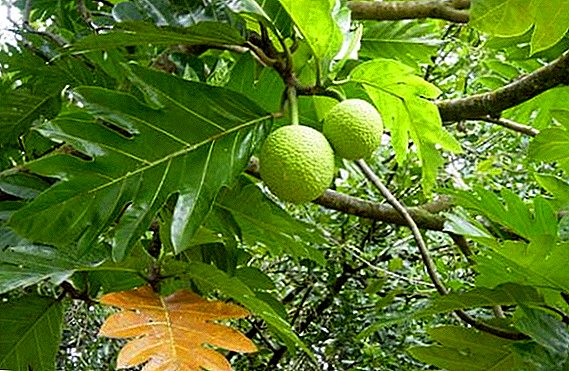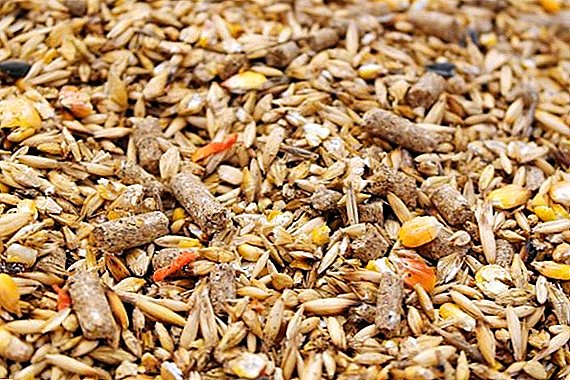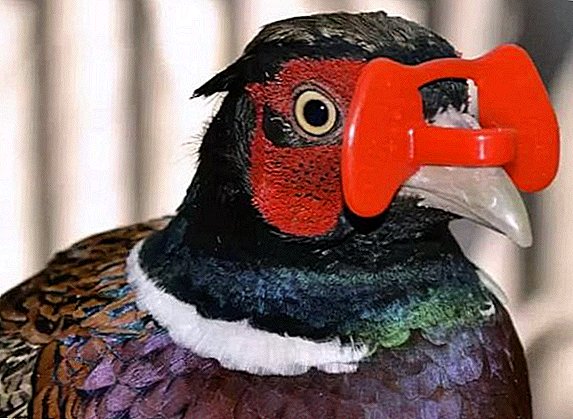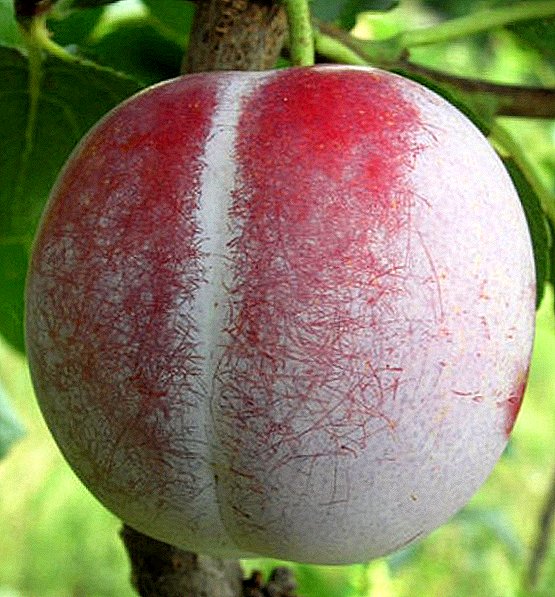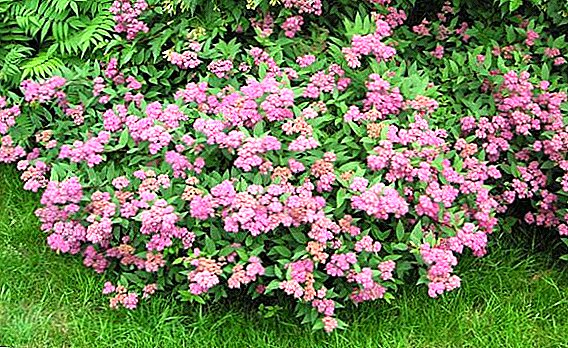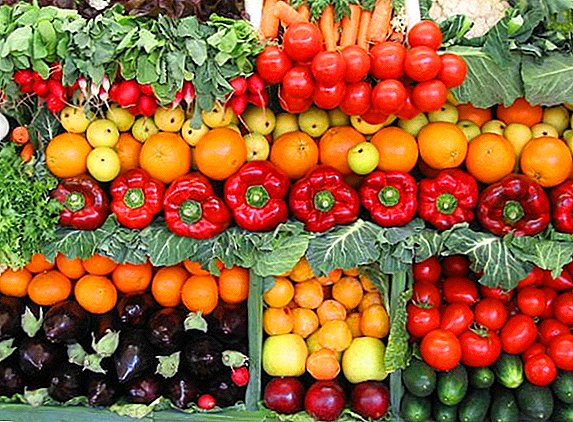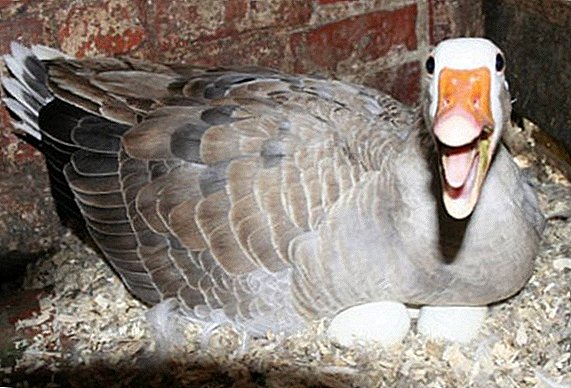 Breeding domestic geese is quite a profitable business, since their summer menu consists of almost 90% of pasture, and the birds themselves do not differ in fastidiousness to content. However, before engaging in the breeding and rearing of birds, novice poultry farmers would not hurt to figure out how to properly put a goose on eggs and provide it with proper care.
Breeding domestic geese is quite a profitable business, since their summer menu consists of almost 90% of pasture, and the birds themselves do not differ in fastidiousness to content. However, before engaging in the breeding and rearing of birds, novice poultry farmers would not hurt to figure out how to properly put a goose on eggs and provide it with proper care.
How many geese are sitting on eggs
In most breeds of geese, puberty comes rather late, at 8-9 months. However, expect it before the onset of spring, not worth it. At this time, the instinct for breeding wakes up among the birds, therefore, the poultry farmers should prepare a nest for laying in the hidden place of the house. If this is not done, then it is likely that the goose will find a place in the poultry yard itself and egg-laying will start prematurely, which does not guarantee the hatching of the chicks.
Did you know? In natural conditions, leaving its nest with future chicks, the goose always masks, hides it from prying eyes with the help of twigs, knots, leaves or grass.Typically, the process of incubation lasts about one month. If during this period the eggs warmed up and turned over evenly, then already after 28-31 days the goslings will begin to "hatch".
 It is very important to create favorable conditions for the goose, to isolate it from other relatives, to organize good nutrition and access to clean water. Of course, the process of incubation of chicks will be much more productive if several hens take part in this process. But at the same time they need to be placed in such a way that they do not see each other.
It is very important to create favorable conditions for the goose, to isolate it from other relatives, to organize good nutrition and access to clean water. Of course, the process of incubation of chicks will be much more productive if several hens take part in this process. But at the same time they need to be placed in such a way that they do not see each other.Check out the most cost-effective geese breeds.
How many eggs are
Unfortunately, geese are not too adapted for laying, as the main purpose of their cultivation is to get tasty dietary meat. Therefore, novice poultry farmers should not count on a large number of eggs, because for a good egg-laying there are different breeds of chickens.
Depending on the breed, geese reach sexual maturity at the age of 280-375 days. At the same time, egg-laying begins.
Important! The term of egg production depends not only on the goose breed, but also on its external dimensions. It is proved that more well-fed females begin to be born earlier.In the first year of life, the goose cannot boast of high productivity, because it is only 30-40 eggs. On the second and third years, these figures, while maintaining a balanced diet and quality care, doubled, reaching 80 pcs.
 It was noted that egg production rates may differ depending on the conditions of detention: with pasture feeding, productivity decreases, and with good fattening in closed poultry houses, on the contrary, it increases. The maximum rate for all breeds usually does not exceed 120 eggs per year.
It was noted that egg production rates may differ depending on the conditions of detention: with pasture feeding, productivity decreases, and with good fattening in closed poultry houses, on the contrary, it increases. The maximum rate for all breeds usually does not exceed 120 eggs per year.As a rule, the majority of geese occur one cycle of egg-laying per year. But there are those whose cycle repeats twice and even three times.
We advise you to find out what the geese are sick of, methods of preventing and treating birds.
Landing methods
Not only beginner poultry farmers, but also very experienced ones may face a problem when the geese do not want to sit on the eggs. Many farmers, in order to stimulate active incubation, place eggs in the nests.
But sometimes even competent stimulation cannot force the bird to hatch chicks. In such cases, use two methods of landing: voluntary and compulsory.  The voluntary method is to create ideal conditions for the potential hen, which imply:
The voluntary method is to create ideal conditions for the potential hen, which imply:
- moving the nest to a separate room;
- maintaining a comfortable temperature regime not lower than +12 degrees and an optimum humidity of 60-75%;
- creating a quiet, dimly lit environment;
- remove any odors and noises.
Did you know? There is a simple method of testing how good a goose will be a hen. If you walk up to the bird when it sits on a nest, then a good "mommy" will begin to defend, hiss, raise wings, etc. Conversely, if the goose runs away, then it is not suitable for incubating.
Voluntary
By recreating such conditions and leaving the goose in the house where it was rushing, it is possible to ensure that it starts the process of hatching. But if under such circumstances this did not happen, then you can force the bird to sit on eggs.
Video: How to understand that the goose is preparing to sit on the nest
Forced
Experienced poultry farmers before starting the proposed egg-laying set the bird into a separate nest and cover it so that it could not get out. For the shelter using a wooden basket, paper box, etc. In order for the goose to activate the instinct, it is enough 3-4 days. At the same time, during the day, dim lighting is left in the room, and at night the light is completely turned off. If a few days later the bird remains in the nest and does not make any attempts to escape from it when removing the box, then it can be safely used for hatching goslings.
Important! It is recommended to begin the process of forced incubation not earlier than February, when it gets a little warmer. It is optimal if masonry ends in March-April in regions with a warm climate and in late April-early May in an area with a cold climate.
How to plant eggs
In order for the process of hatching eggs to end with the successful hatching of healthy offspring, one should know which eggs should be laid and when the hen should be planted. 
When to plant
As mentioned above, the process of planting a goose should begin when it gets a little warmer in the yard, around the end of March and early April. When the bird has landed on the eggs, you should see if the heating area corresponds to the number of eggs. Usually, a small female is able to fully heat 8-10 pieces, a larger one - up to 15.
Owners of geese in the household will be interested in finding out how goose fat, meat and eggs are useful.
In the process of hatching, you should take eggs from time to time and check them for dirt, possible chips or cracks. Bad material should be removed.
What eggs to put
Important is the choice of quality lining material. There are several important requirements for it:
- eggs must be fresh, medium size (from 120 to 150 g);
- it is recommended to put an oval-shaped material under the layer;
- the surface of the "lining" should be smooth, without rough edges;
- The material should not contain lime deposits.
 In order to stimulate the nestling instinct of a goose, she is first placed in a nest with dummies or, if there are none, previously laid eggs, which are previously marked. When the process of "sitting down," eggs change to fresh.
In order to stimulate the nestling instinct of a goose, she is first placed in a nest with dummies or, if there are none, previously laid eggs, which are previously marked. When the process of "sitting down," eggs change to fresh.
Important! The exchange of lining material is carried out when the bird leaves the nest, for example, while it eats feed. Otherwise, you can frighten her and she will refuse to hatch.In order to get the desired result, you must:
- regularly examine the eggs, ideally - to enlighten them with an ovoscope for the presence of fertilization. Material without embryos should be removed immediately;
- move the eggs from the edges to the center so that they warm up evenly;
- dropped from the nest specimens clean up.
Tips
The process of brooding chicks will be as successful as possible if the poultry farmers adhere to simple but important rules:
- to determine the approximation of the incubation period can be based on the fact that molting. When a bird starts to molt, feathers fall and fluff it uses as a material for arranging the nest. At this time, it is necessary to lay the dummies in the nest or leave the eggs laid in it, otherwise the laying process can continue for a very long time;
- choosing future parents, it is necessary to ensure that the drake and goose are not close relatives, otherwise it will adversely affect the fertilization of the material;
- The eggs that will be used for incubation must be properly stored. Experts recommend collecting them when they are still warm. In this case, the egg is taken with two fingers, one of which is placed on the stupid end, and the other - on the sharp. Next, the eggs are transferred to a cool dry place. Dirty specimens need to be cleaned within two hours after demolition;
- during the hatching the bird should organize a complete, balanced diet and provide constant access to fresh water, dry food, mineral supplements. This will provide an opportunity to prevent depletion of the body. The best feed during the incubation are dry cereal mixtures. The consumption of wet mash is undesirable because they can cause a breakdown of the digestive system;
- during the period of cooling in the room where the hen is located, it is recommended to install additional heat sources;
- if the hen does not rise more than two days from the nest, it must be forcibly removed and brought to the trough with food.

You can get goose offspring with an incubator. To do this, you need to know how to select and store goose eggs, as well as some features of incubating goose eggs.

Reviews



